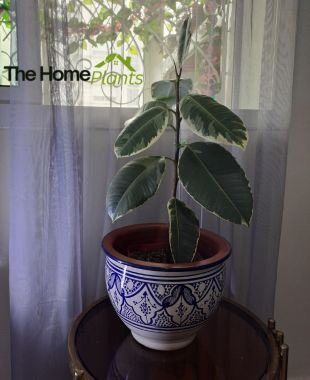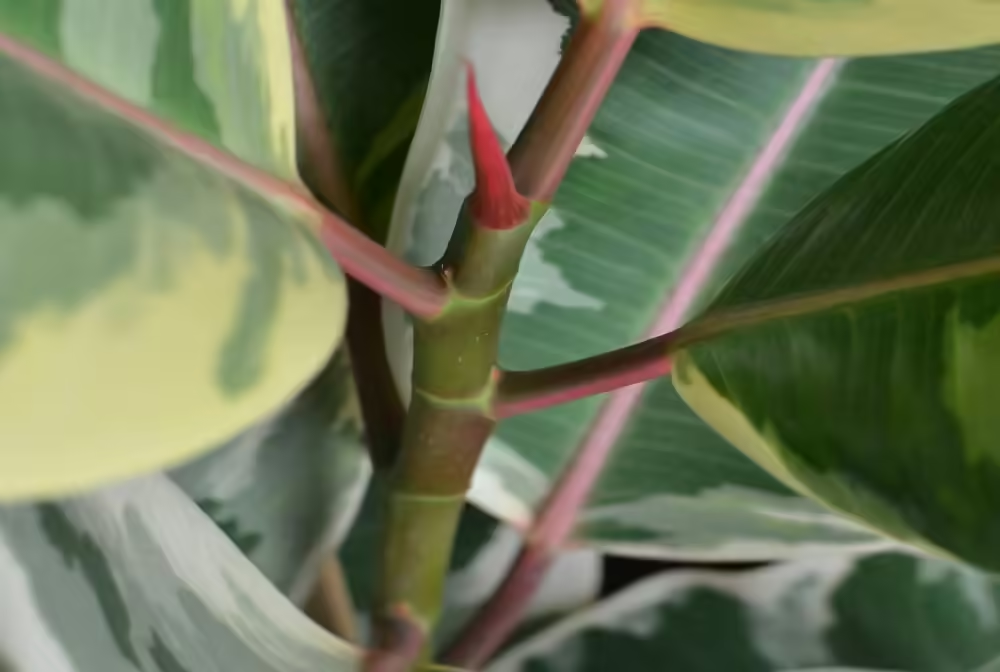The variegated rubber tree plant is more than just a houseplant—it’s a showstopper.
With its striking mix of green, cream, and yellow leaves, it’s the perfect way to bring bold, natural beauty into your home. Whether you’re a seasoned plant enthusiast or a beginner, this plant is a low-maintenance option that offers both style and function. Not only does it purify the air, but it also grows into a statement piece that can transform any room.
Let’s dive into how you can care for, propagate, and enjoy the many benefits of this beautiful indoor tree.
Needs of Variegated Rubber Tree Plant
The variegated rubber tree plant (Ficus elastica), known for its striking green and cream-colored leaves, is both a statement piece and a relatively easy houseplant to care for. But like any plant, it has a few key needs to keep in mind.
- Light: The variegated rubber tree plant prefers bright, indirect light. Its variegation (the beautiful mix of colors on its leaves) is more pronounced with plenty of light. While it can tolerate lower light conditions, you might notice the leaves becoming less vibrant. Place it near an east or north-facing window for optimal growth. If you can’t give it enough light, consider supplementing with grow lights.
- Temperature: This plant enjoys warm conditions, mimicking the tropical climates it naturally thrives in. Ideal temperatures range between 60-80°F (16-27°C). Avoid cold drafts or extreme temperature shifts, as they can cause leaf drop. A sudden drop below 50°F (10°C) can harm the plant.
- Humidity: While the variegated rubber tree can survive in average indoor humidity, it does better with a little more moisture in the air. It won’t suffer in normal home conditions, but if you live in a particularly dry area or notice the leaves curling, consider misting the plant or placing a humidifier nearby. Bathrooms or kitchens with indirect light are often perfect spots for this plant.
- Soil: This plant needs well-draining soil. A mix of standard potting soil with perlite or coarse sand works well to prevent waterlogging. Rubber plants don’t like soggy roots, so the right soil mix is crucial.
- Watering Needs: Water the plant thoroughly but infrequently. Allow the top 1-2 inches of soil to dry out between watering sessions. During the growing season (spring and summer), you may need to water more often, but always check the soil before adding water.
How to Take Care of Variegated Rubber Tree Plant
Caring for a variegated rubber tree plant is a rewarding experience, especially since it’s relatively low-maintenance. However, there are a few important care tips to ensure it thrives.
- Difficulty: This plant is easy to medium in terms of care. It’s a tough plant that can tolerate occasional neglect, making it perfect for both beginners and more experienced plant parents. However, attention to detail, especially with light and watering, will keep it looking its best.
- Watering Routine: As mentioned earlier, the plant prefers to dry out slightly between waterings. A good rule of thumb is to water when the top 1-2 inches of soil is dry. Water deeply, ensuring the water reaches the roots. Reduce watering in the fall and winter when the plant’s growth slows down.
- Fertilization: During the growing season, feed the plant with a balanced liquid fertilizer every four weeks. For even better results, use a slow-release fertilizer in the spring, which will provide nutrients over time.
- Leaf Care: One common issue with variegated rubber trees is dust buildup on their broad leaves. Since they’re dust magnets, it’s essential to wipe them down regularly with a damp cloth. This not only keeps the plant looking fresh but also helps it photosynthesize more effectively.
- Pruning: This plant can grow quite tall indoors, sometimes reaching up to 10 feet! Regular pruning helps control its height and encourages bushier growth. Prune in early spring before the growing season starts, and always use clean, sharp shears to prevent any damage to the plant.
- Repotting: Your variegated rubber tree plant will need to be repotted every 1-2 years or whenever it outgrows its pot. Look for signs like roots growing out of the drainage holes or water draining too quickly. When repotting, choose a container 2-3 inches wider than the current pot and use fresh, well-draining soil.
Baby Rubber Plant Care
If you’re starting out with a baby variegated rubber tree plant, the basic principles remain the same, but you’ll want to handle it with a little extra care.
- Watering: Young rubber plants are more sensitive to overwatering. Water only when the topsoil is dry, and make sure the pot has good drainage.
- Light: Provide the young plant with bright, indirect sunlight. Too little light will stunt its growth, and too much direct sunlight can scorch the leaves.
- Repotting: Baby rubber plants grow relatively fast, so you might need to repot them more frequently than mature plants, especially in their first few years.
Benefits and Cons of Variegated Rubber Tree Plant
When it comes to houseplants, the variegated rubber tree brings plenty of advantages to the table, but like any plant, it has a few downsides too.
Benefits:
- Toxin Removal: The variegated rubber tree is known to remove harmful toxins like formaldehyde from the air. NASA’s research has proven the ability of plants to purify indoor environments, and this plant is a top performer in that category.
- Air Purification and Oxygen Production: In addition to eliminating toxins, it increases oxygen levels and reduces indoor air pollutants, helping to create a healthier living space.
- Well-Being Booster: Having plants like the variegated rubber tree in your home has been shown to improve mood, reduce stress, and even increase productivity.
- Low Maintenance: Compared to other large indoor plants, the rubber tree requires minimal care. As long as it has the right light and occasional watering, it will thrive.
- Longevity: With proper care, this plant can last for years. I’ve personally had mine for over five years, and it continues to grow and thrive.

- Room Transformation: The variegated rubber tree makes a bold, decorative statement with its large, glossy, variegated leaves. It’s perfect for filling empty spaces or corners of a room.
Cons:
- Dust Accumulation: The large, waxy leaves tend to attract dust, so regular cleaning is necessary to keep the plant healthy.
- Toxic to Pets: The sap and latex from the rubber tree are toxic to cats and dogs, so if you have pets, you’ll need to keep it out of their reach.
- Allergies: Some people may have an allergic reaction to the latex that the plant produces, which can cause skin irritation.
- Size: Over time, the plant can grow quite large. This might be a challenge in smaller spaces, and regular pruning may be necessary to keep it manageable.
How to Propagate a Rubber Plant
Propagating a variegated rubber tree plant is an easy way to grow new plants, whether to expand your indoor garden or gift to fellow plant lovers. Here’s how:
- Cut the Stem: Use clean, sharp shears to cut off a section of the plant, preferably 4-6 inches in length. Make sure the stem cutting has a few leaves near the top and no leaves at the bottom.
- Prep the Stem: Remove any leaves from the lower half of the stem. The leaves in the water can rot and contaminate your cutting. The bare stem will also allow roots to form more easily.
- Root in Water: Place the stem into a jar of water, making sure that the bottom part is fully submerged. Place the jar in a spot with bright, indirect light.
- Wait for Roots: Be patient, as rubber tree cuttings can take a few months to develop thick, healthy roots. Change the water every week or when it becomes murky to prevent bacteria buildup.
- Transfer to Soil: Once the roots have developed and are around 1-2 inches long, you can transplant the cutting into a pot with well-draining soil.
Final Thoughts
The variegated rubber tree plant is a fantastic addition to any indoor garden. Its large, colorful leaves make a bold decorative statement, while its air-purifying abilities add practical benefits to your home. With relatively low maintenance requirements, this plant can thrive for years with the right care, and it’s easy to propagate if you want to expand your collection. Whether you’re a seasoned plant lover or a beginner, the variegated rubber tree is a rewarding plant to grow, care for, and admire in your space.

